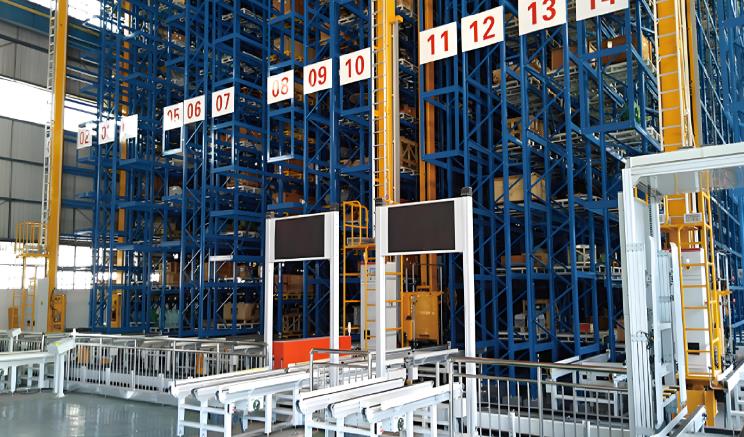what is two way radio shuttle?
A two-way radio shuttle, also known as a radio shuttle system, is a type of automated storage and retrieval system (AS/RS) used in warehouses and distribution centers for efficient storage and retrieval of goods. It is designed to work in combination with racking systems.
Here's how a two-way radio shuttle system typically operates:
1. Shuttle Vehicle: The system consists of a shuttle vehicle, which is a battery-powered device that runs along the racking system's guide rails. The shuttle vehicle is capable of carrying and transporting pallets or other load units within the racking system.
2. Racking System: The racking system is specifically designed to accommodate the shuttle vehicle. It consists of deep lanes of storage racks with guide rails or tracks on each level for the shuttle to navigate.
3. Radio Communication: The shuttle vehicle is equipped with radio communication capabilities, allowing it to receive commands and transmit information to and from a central control system.
4. Loading and Unloading: Operators use forklifts or stacker cranes to load the shuttle vehicle with pallets at the system's entry point. The shuttle vehicle then transports the loaded pallets to a designated storage location within the racking system.

5. Storage and Retrieval: Once inside the racking system, the shuttle vehicle places the pallets in the appropriate storage location based on instructions received from the control system. It can efficiently move pallets horizontally and vertically within the racking system.
6. Retrieval and Dispatch: When a specific pallet needs to be retrieved, the shuttle vehicle locates it within the racking system and brings it to the system's exit point. From there, operators can unload the pallet using forklifts or other equipment for further processing or shipping.
Key features and benefits of a two-way radio shuttle system include:
- High-density storage: The system maximizes storage capacity by utilizing the vertical space within the racking system and efficiently utilizing deep lanes of storage.
- Fast and precise operations: The shuttle vehicle can quickly move and position pallets within the racking system, allowing for fast retrieval times and precise placement.
- Increased productivity: By automating the storage and retrieval process, it reduces the reliance on manual labor and improves overall operational efficiency.
- FIFO and LIFO options: The system can be configured to operate in either a first-in, first-out (FIFO) or last-in, first-out (LIFO) mode, depending on the specific storage and retrieval requirements.
- Scalability: The system is highly scalable, allowing for easy expansion by adding more shuttle vehicles or extending the racking system as the storage needs grow.
More detailed explanations of some key aspects of two-way radio shuttle systems:
System Control and Software Management:
The central control system of a two-way radio shuttle system is responsible for managing and coordinating the movement of shuttle vehicles. It communicates with the shuttle vehicles via radio frequency signals, providing them with instructions for tasks such as storage, retrieval, and positioning of pallets. The control system is typically supported by software that acts as the brain of the system. This software manages the inventory, tracks the location of each pallet within the racking system, and optimizes the storage and retrieval process. It can prioritize tasks, assign shuttle vehicles to specific orders, and calculate the most efficient routes for moving pallets.
Multi-Level Capability:
Two-way radio shuttle systems are designed to operate on multiple levels of racking, allowing for efficient vertical storage and retrieval of pallets. The shuttle vehicles can move between different levels using ramps or lifts, accessing the desired storage locations. This multi-level capability enables the system to maximize the use of vertical space in the warehouse, making it ideal for facilities with high ceilings and a need for dense storage.
High Throughput:
Two-way radio shuttle systems are known for their high throughput capabilities. With multiple shuttle vehicles operating simultaneously within the racking system, they can handle a large volume of pallet movements. The control system optimizes the routing and task assignments to minimize idle time and maximize efficiency. This high throughput capability is especially beneficial in busy warehouse environments where speed and productivity are essential.
Compatibility with Various Load Types:
Two-way radio shuttle systems are versatile and can accommodate various load types. They can handle pallets of different sizes, weights, and configurations. The system can be customized with adjustable forks or attachments to securely transport and position different load types within the racking system. This flexibility allows businesses to handle diverse product ranges and adapt to changing storage requirements.
Integration with Warehouse Management Systems (WMS):
Two-way radio shuttle systems can integrate with a warehouse management system (WMS) for seamless data exchange and enhanced inventory management. The integration enables real-time tracking of inventory, accurate order fulfillment, and efficient warehouse operations. The WMS provides information on incoming and outgoing orders, inventory levels, and order priorities to the shuttle system's control software. This integration streamlines the flow of information and enables better synchronization between different warehouse processes.
Safety Features:
Two-way radio shuttle systems incorporate various safety features to ensure the well-being of personnel and the protection of equipment. Collision avoidance sensors are installed on the shuttle vehicles to detect obstacles and prevent collisions. Emergency stop buttons and safety barriers may be included to halt the system's operation in case of emergencies. These safety features help create a secure working environment and prevent accidents within the warehouse.
Cost Considerations:
Implementing a two-way radio shuttle system involves a capital investment due to the automation and advanced technology involved. The cost will depend on several factors, including the size of the facility, required throughput, racking configuration, and customization options. It's important to consider the long-term benefits, such as increased productivity, space optimization, and improved inventory management when evaluating the cost-effectiveness of implementing a two-way radio shuttle system.
Two-way radio shuttle systems are commonly used in industries with high-density storage requirements, such as food and beverage, cold storage, and manufacturing, where efficient utilization of warehouse space and fast retrieval times are crucial.
